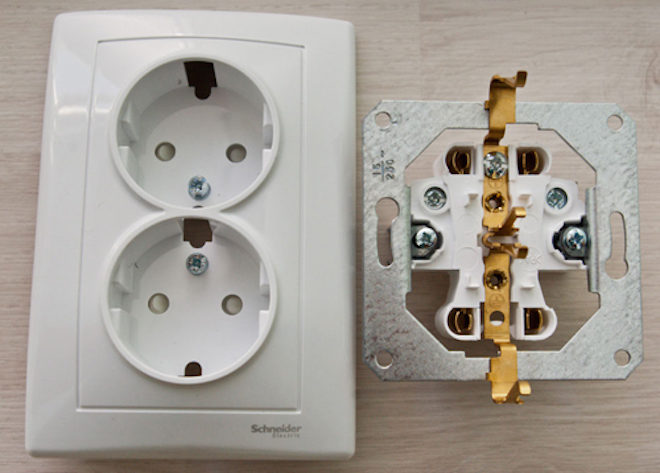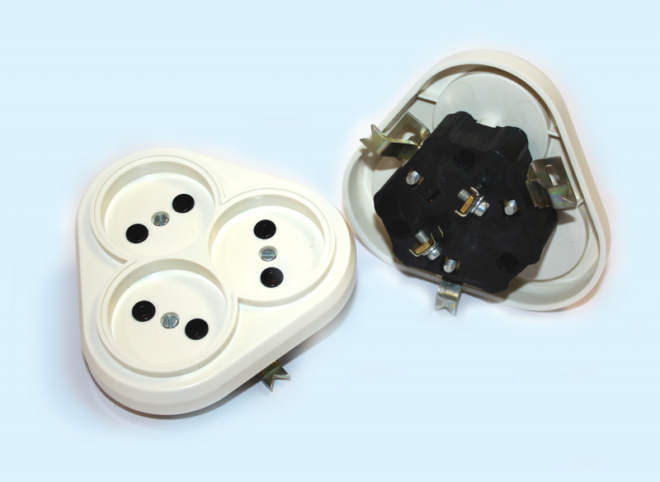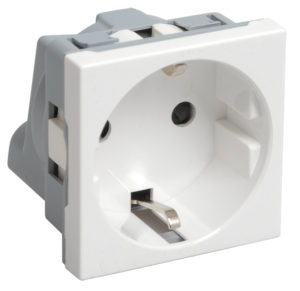How to properly connect a double or triple outlet
There are usually enough free sockets in an apartment, but it often turns out that at least two devices must be plugged into one of them. The solution to the problem is very simple, if you take care of how to connect a double socket in advance. This is one of the most reliable ways to once and for all solve the problem of falling tees, which in parallel loosen the contacts of single sockets.
Content
What are double or triple sockets

A typical socket is made of metal contacts fixed in a dielectric housing. Wires are bolted to each of them. A double socket, installed in one socket, consists of the same contacts, only they are made along the edges of the plate and each of them has a bolt fastener for a phase or neutral wire. Since a copper or brass plate in any case has a higher throughput than a wire, it is he who is a potential "weak link", therefore, when connecting a double socket, tightening the contacts must be taken with all attention.
The schematic diagram of connecting a triple outlet is no different from a double one - phase and zero are supplied to the contacts that are on copper or brass plates. Between themselves, the triple sockets are structurally distinguished by triangular or ribbon. Their second version is the same double, but with an additional socket for a third plug - all contacts are on solid plates. Triangular, in turn, have to be made from several pieces, connecting them together with rivets. Theoretically, this somewhat reduces the reliability of the contacts, but if you do not violate the rules of operation, then the triangular triple socket, installed in one socket, will work without complaints for many years.
Why double socket
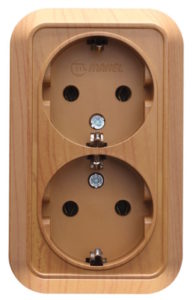 The disadvantages of the solution to install a double socket are very difficult to find. Probably the only argument against it, it is most likely expressed simply "out of harm" and says that its connection to the network increases the risk of overload - except for families that have electricians, no one will even think about "pulling" whether one point is two powerful electrical appliances.
The disadvantages of the solution to install a double socket are very difficult to find. Probably the only argument against it, it is most likely expressed simply "out of harm" and says that its connection to the network increases the risk of overload - except for families that have electricians, no one will even think about "pulling" whether one point is two powerful electrical appliances.
In practice, to connect such devices that consistently consume high amperage current, separate outlets are made, therefore, under normal conditions, several factors must converge for a prolonged dangerous overload to occur, the combination of which seems very, very unlikely.
What is the average outlet designed for?
The first moment is the current strength that the outlet can withstand - usually this parameter is indicated on its cover, less often on the inside. Old Soviet devices, which are now less and less often found (they are replaced almost primarily because of the need to connect modern europlugs), in the bulk, are designed for a current of 6 Amperes. Modern ones, even of mediocre quality, are marked already 10 (if it is without grounding) or 16 Amperes.
What these numbers mean will help to find out the school formula for calculating the power of an electric current - even humanities should understand it. P (power) = I (current) * U (voltage), and given that the voltage in the household network is always constant and equal to 220 Volts, it is quite simple to calculate what the marking by current strength indicates.
- 220 Volts * 6 Amperes = 1320 Watt = 1.3 kW
- 220 Volts * 10 Amperes = 2200 Watt = 2.2 kW
- 220 Volts * 16 Amperes = 3520 Watt = 3.5 kW
Household electrical appliances power
You can clearly imagine where you can safely connect a double outlet by comparing the most commonly used electrical appliances:
Considering the recommendations of the PUE: how to correctly connect powerful kitchen appliances, boilers and air conditioners - a separate line is always supplied to them, it is very difficult to imagine in what situation the installation of a double outlet will entail the simultaneous inclusion of two devices with a total power of more than 2.2 kW. It is quite problematic to use an iron at the same time with a vacuum cleaner or a hairdryer - only a microwave oven with an electric kettle remain, but together they work for a maximum of 5-8 minutes, and the safety margin in electrical engineering is not an empty phrase. Plus, good 16 Ampere sockets are usually installed for such electrical appliances.
Installation of double and triple sockets
 There is no difference between how to connect a triple outlet, double or single - all the steps are exactly the same. Of course, all work must be done with the electricity off:
There is no difference between how to connect a triple outlet, double or single - all the steps are exactly the same. Of course, all work must be done with the electricity off:
- A hole is drilled in the wall, where the socket box and strobe will be installed, through which the wire will be supplied (if installation is performed from scratch).
- A gypsum or cement mortar is being prepared - a little so that it is enough to fix the socket in the wall.
- A socket box is installed flush with the wall (the wires are wound inside it, and before that, their ends must be wrapped with electrical tape so that the gypsum solution does not get on the veins). Then you need to wait for the allotted time for the solution to completely harden - depending on the composition, this can take from 15 minutes to a day.
- Further, the electrical tape is removed from the ends of the wires, if necessary, the required amount of insulation, the conductors are inserted into the contact fasteners and tightened. Contrary to some opinions, there is no difference how to connect a triple outlet (this also applies to double and single) - the phase wire can be clamped both on the right contact and on the left. The main thing is that there is good contact between the core and the terminal, to increase its area, the core can be flattened a little with pliers.
- Then the inner part is installed in the socket box - you don't have to expose anything here, since it has a limiter that presses it against the wall. When the socket is fully aligned, the spacer lugs are tightened and the stopper is screwed onto the socket.
- The last step is to secure the cover - it is bolted to the inside with screws.
At what step you need to turn on the electricity depends solely on the degree of curiosity - whether the connection is correct or not. You can check the voltage immediately after connecting the wires, after installing the interior in the socket box or after the installation is completely completed.
The installation process for a double socket is shown in this video:
Double and triple sockets, recruited from ordinary

The meaning of such a connection is that the phase and neutral wires are suitable from the junction box to one of the sockets, and the third is connected from its terminals by the next wire, and so on. In fact, it turns out not double, but double (triple) sockets that are connected to a separate unit, which is still powered from one wire.
A row of outlets connected in this way is easy to repair - if any part of it fails, then only the broken part will have to be replaced.
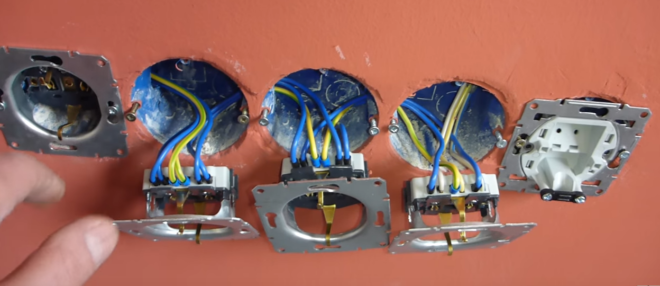
The wire connecting the blocks of sockets is selected with the same cross section as the one that comes to the first of them. If the same is not there, then without any special problems you can take wires with a core of a larger cross-section, but in no case is it the other way around - with a load greater than the gentle one, the wire connected to such contacts will soon begin to heat up and oxidize.Socket blocks are generally installed in places where the use of a large number of powerful devices is not expected, although if the supply and connecting wires of a sufficient cross-section and the contacts of the sockets are well clamped, then they will freely withstand the operation of the heater in tandem with several more devices.
There is another nuance when installing socket boxes - you can install them one at a time, or find a whole block that is immediately inserted into the holes drilled in the wall. Otherwise, everything is done in the same way as with a regular outlet.
A detailed story about connecting the block of outlets in this video:
Which is better to choose
As a result, the use of double and triple sockets is a great alternative to the need to connect to ordinary carriers, tees and other devices that allow several devices to work from one point at once.
The only rule that you need to remember, without bothering yourself with calculating kilowatts, is not to plug several powerful devices, such as heaters, into one outlet or a group of them. In domestic conditions, it is very difficult to imagine a situation when this may be needed, but if such a need arises, then it is better to choose sockets on different, or better opposite, walls.

